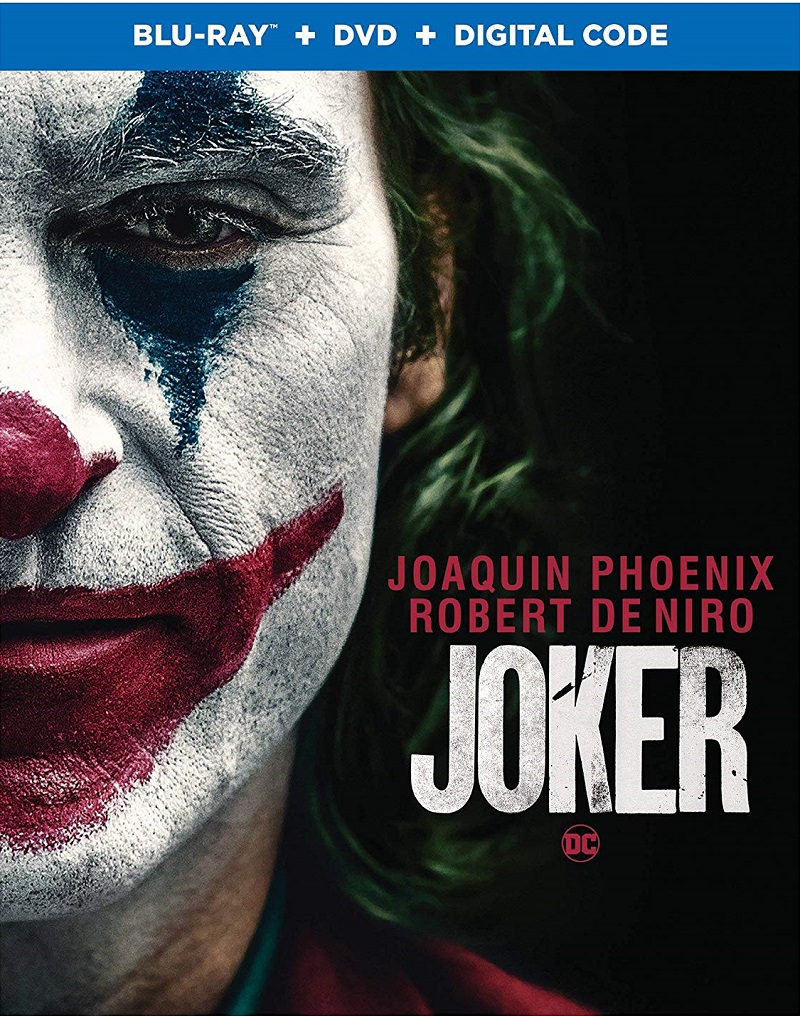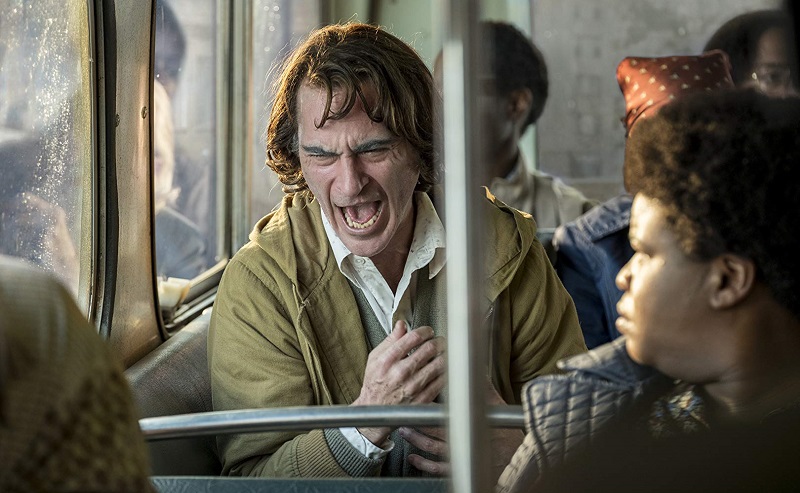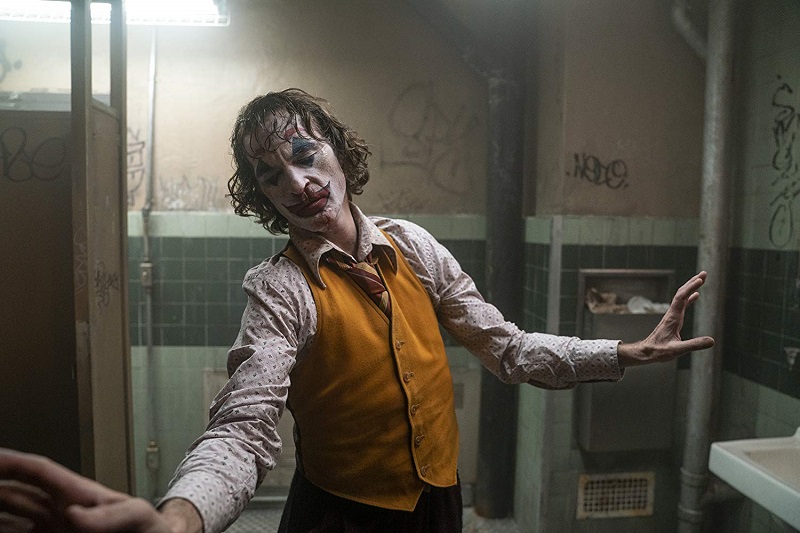Fresh off of winning Best Actor at the Golden Globes, the Joaquin Phoenix starring Joker is out now on DVD, Blu-Ray and digital download formats from Warner Bros. This is a title that you will want to have in your library. Not only does it warrant repeated viewings in the near future, it is a cinematic achievement of the highest order that will undoubtedly stand the test of time. This is a film you will watch five, ten, 20 years from now and will still resonate as powerfully as it did the first time.

Joker introduces us to a 1981 gritty, crime riddled pre-Batman Gotham City. Arthur Fleck (Phoenix) is a struggling clown who does his absolute best to “put on a happy face” and bring joy to others. Most days, he dresses as a clown and essentially carries a sign for local businesses. One of these early in the film work moments helps define the world of Fleck where reality seems to be slipping through his fingers. A group of teenage hooligans grab his sign, he gives chase and in a city alley, they smash the sign into a million pieces over his head. He just lays there, on the ground, in a fetal position that is indicative of the mental space Fleck finds himself in quite frequently.
His home life is not much better. Fleck takes care of his mother, Peggy (Frances Conroy) and does everything he can to bring a smile to her face—even if she’s the only one who benefits from his “happy face” mission. He talks to a therapist, but thanks to budget cuts it appears that she will not be able to help him any more…sadly when it appears that he needs her the most. Fleck’s real dream, being a stand-up comic, has eluded him thus far, but when a tape of part of his act appears on the late night talk show hosted by his hero Murray Franklin (Robert De Niro), perhaps a real change is occurring for his life. Nah, that’s not it. His stand-up tape was part of a joke by Franklin and it stands to be the final straw that brings down the house of cards that is Fleck’s mental well-being.
There are a slew of Easter Eggs to the Batman landscape in Joker that longtime fans and new ones alike will treasure. Fleck meets a young Bruce Wayne at one point and through director Todd Phillips’ wizardry, there appears to be a parallel nature to their collective existence that is utterly fascinating, riveting and compelling.
Phoenix digs deep and delivers what adds up to the most powerful and insightful performance of his career. The entire movie hangs on his gaunt shoulders and through his Fleck persona, not only do we get a front-row seat to the evolution of one of pop culture’s greatest villains, but a layered and nuanced look at mental illness and what can occur when society chews someone up and tosses them out into the world without a safety net. There is a movement that is permeating Gotham and it is firmly anti-establishment. As Fleck becomes Joker, Phoenix plays the titular character as someone whose passion for this crusade becomes like oxygen to him. As he inhales it further, the former Fleck evolves into Joker until the two become one.
Outside his lead actor, Phillips deserves major credit for establishing this world that birthed a mentally unstable, violently driven soul who started out with the best of intentions. After all, he sought to make people smile (and laugh). But when they started laughing at him and not with him, cracks to his mental facade started to form. Phillips, with his astute direction, and contribution to the script he co-wrote that is nothing short of brilliant, has delivered a stand-alone comic book movie that stands head and shoulders above anything that came before—in terms of a character study. This is powerful stuff and a perfect example of filmmaker and thespian coming together in a fateful film moment that will reverberate for decades to come. The gold standard has been set by Joker—not solely with comic book stories, but with character studies of any kind. The evolution of Fleck to Joker will be studied in film studies classes for years to come.

The best of the bonus features has to be Joker: Vision & Fury. The twenty-two minute featurette has Phillips, Phoenix, production designer Mark Friedberg, composer Hildur Guðnadóttir and other key artistic contributors brilliantly adding their thoughts to the creative process headed by Phillips. After experiencing the world of Joker and then taking in this stunning featurette, be prepared for your biggest questions to be answered, yes, but as is the case with most intelligently crafted pieces of art, there will be additional inquiries that will spur you further down the rabbit hole of Fleck and his foibles. The score, which also won a Golden Globe this past weekend, gets its rightful spotlight in this piece and hearing Guðnadóttir talk about her process and the insight she gleaned from Phillips and Phoenix, will only add layers of impressiveness to what the composer accomplished with her chilling score. Also fascinating is hearing Phillips and his creative team talk about the editing process and how much it played a part in eliciting the powerful emotive response audiences had to this film when it premiered.
Becoming Joker is a brief, barely a minute and a half, music-centric piece that literally shows Phoenix transforming from himself, actor, into character that becomes the Joker. Although short, it provides invaluable insight into the thought process of Phillips and how he provided all his cinematic artists the tools to succeed beyond anything they could have imagined.
A slew of still images (some taken by a set photographer, others stills from the movie itself) move at the eye at rapid speed and comprise the featurette, Joker: A Chronicle of Chaos. Adding to the haunting power of the visual is the stellar score by Guðnadóttir.

Rarely do we get a Blu-Ray extra that is like Please Welcome… Joker! This just under three-minute featurette gives viewers multiple takes on the same scene. Again, showcasing the creative genius of Phillips and all who he employed to bring Joker to life, this featurette shines a light on radically distinct performances of the same material and how that gave Phillips and his editing team such a rich palette to paint their masterpiece.
Film Grade: A+
Bonus Features: A

